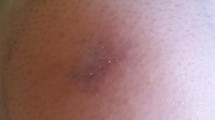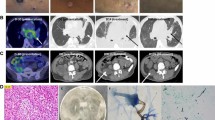Abstract
Mucormycosis is an uncommon opportunistic fungal infection caused by Zygomycetes. It usually affects immunocompromised, diabetic and trauma patients with infected wounds. We report a case of disseminated infection secondary to facial cutaneous mucormycosis caused by Saksenaea vasiformis in a diabetic patient who had a farming accident causing him severe head injury. The patient was treated with a combination of surgical debridement and antifungal therapy with liposomal amphotericin B, but he had a slow and fatal outcome. In cases of tissue necrosis following trauma involving wound contact with soil (i.e., potential fungal contamination), testing for the presence of Zygomycetes fungi such as S. vasiformis in both immunocompetent and immunocompromised patients is crucial. The reason is that this infection usually has a rapid progression and may be fatal if appropriate treatment is not administered.


Similar content being viewed by others
References
Ibrahim AS, Spellberg B, Walsh TJ, Kontoyiannis DP. Pathogenesis of mucormycosis. Clin Infect Dis. 2012;54(Suppl 1):S16–22.
Petrikkos G, Skiada A, Lortholary O, Roilides E, Walsh TJ, Kontoyiannis DP. Epidemiology and clinical manifestations of mucormycosis. Clin Infect Dis. 2012;54(Suppl 1):S23.
Gomes MZ, Lewis RE, Kontoyiannis DP. Mucormycosis caused by unusual mucormycetes, non-Rhizopus, -Mucor, and -Lichtheimia species. Clin Microbiol Rev. 2011;24:411–45.
Ribes JA, Vanover-Sams CL, Baker DJ. Zygomycetes in human disease. Clin Microbiol Rev. 2000;13:236–301.
Vega W, Orellana M, Zaror L, Gené J, Guarro J. Saksenaea vasiformis infections: case report and literature review. Mycopathologia. 2006;162:289–94.
Taj-Aldeen SJ, Falamarzi A, AlMuzrkchi A, Guarro J. Rare pediatric rhino-orbital infection caused by Saksenaea vasiformis. Infection. 2012;40:703–7.
Holden DW. DNA mini prep method for Aspergillus fumigatus (and other filamentous fungi). In: Maresca B, Kobayashi GS, editors. Molecular biology of pathogenic fungi, a laboratory manual. New York, NY: Telos Press; 1994. p. 3–4.
Saksena SB. A new genus of the Mucorales. Mycologia. 1953;45:426–36.
Alvarez E, Garcia-Hermoso D, Sutton DA, et al. Molecular phylogeny and proposal of two species of the emerging pathogenic fungus Saksenaea. J Clin Microbiol. 2010;48:4410–6.
Ajello L, Dean DF, Irwin RS. The zygomycete Saksenaea vasiformis as a pathogen of humans with a critical review of the etiology of zygomycosis. Mycologia. 1976;68:52–62.
Baradkar VP, Mathur M, Taklikar S, Rathi M, Kumar S. Fatal rhino-orbito-cerebral infection caused by Saksenaea vasiformis in an immunocompetent individual: first case report from India. Indian J Med Microbiol. 2008;26:385–7.
Kompoti M, Michalia M, Kallitsi G, Giannopoulou P, Arabatzis M, Liapi G, Velegraki A, Trikka-Graphakos E, Clouva-Molyvdas PM. Fatal cutaneous Saksenaea vasiformis infection in a critically ill trauma patient. Mycoses. 2011;54:599–601.
García-Martínez J, López-Medrano F, Alhambra A, Del Palacio A. Rhinocerebral zygomycosis caused by Saksenaea vasiformis in a diabetic patient. Mycoses. 2008;51:549–53.
Gonis G, Starr M. Fatal rhinoorbital mucormycosis caused by Saksenaea vasiformis in an immunocompromised child. Pediatr Infect Dis J. 1997;16:714–6.
Baradkar VP, Kumar S. Cutaneous zygomycosis due to Saksenaea vasiformis in an immunocompetent host. Indian J Dermatol. 2009;54:382–4.
Padhye AA, Ajello L. Simple method of inducing sporulation by Apophysomyces elegans and Saksenaea vasiformis. J Clin Microbiol. 1988;26:1861–3.
Bearer EA, Nelson PR, Chowers MY, Davis CE. Cutaneous zygomycosis caused by Saksenaea vasiformis in a diabetic patient. J Clin Microbiol. 1994;32:1823–4.
Ayats J, Martín-Mazuelos E, Pemán J, Quindós G, Sánchez F, García-Rodríguez J, et al. Spanish society of clinical microbiology and infectious diseases (SEIMC) guidelines for the diagnosis of invasive fungal infections. 2010 update. Enferm Infecc Microbiol Clin. 2011;29(39):e1–15.
Walsh TJ, Gamaletsou MN, McGinnis MR, Hayden RT, Kontoyiannis DP. Early clinical and laboratory diagnosis of invasive pulmonary, extrapulmonary and disseminated mucormycosis (zygomycosis). Clin Infect Dis. 2012;54(Suppl 1):S55–60.
Lanternier F, Lortholary O. Liposomal amphotericin B: what is its role in 2008? Clin Microbiol Infect. 2008;14(Suppl 4):S71–83.
Rammaert Blandine, Lanternier Fanny, Zahar Jean-Ralph, et al. Healthcare-associated mucormycosis. Clin Infect Dis. 2012;54(Suppl 1):S44–54.
Domínguez MdelC, Sánchez J, Carmona E, Vergara-López S. Elderly patient with rapidly progressive skin lesions. Enferm Infecc Microbiol Clin. 2012;30:43–5.
Spellberg B, Ibrahim A, Roilides E, et al. Combination therapy for mucormycosis: why, what, and how? Clin Infect Dis. 2012;54(Suppl 1):S73–8.
Gómez-López A, Cuenca-Estrella M, Monzón A, Rodríguez-Tudela JL. In vitro susceptibility of clinical isolates of Zygomycota to amphotericin B, flucytosine, itraconazole and voriconazole. J Antimicrob Chemother. 2001;48:919–21.
Acknowledgments
The authors thank the National Center of Microbiology of Majadahonda (Madrid, Spain) for their technical support.
Conflict of interest
The authors certify no conflicts of interest in relation to this article exist.
Author information
Authors and Affiliations
Corresponding author
Rights and permissions
About this article
Cite this article
Gómez-Camarasa, C., Rojo-Martín, M.D., Miranda-Casas, C. et al. Disseminated Infection due to Saksenaea vasiformis Secondary to Cutaneous Mucormycosis. Mycopathologia 177, 97–101 (2014). https://doi.org/10.1007/s11046-013-9715-3
Received:
Accepted:
Published:
Issue Date:
DOI: https://doi.org/10.1007/s11046-013-9715-3




